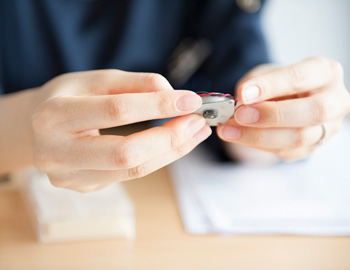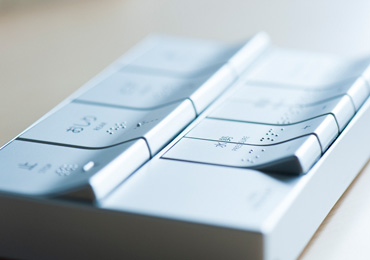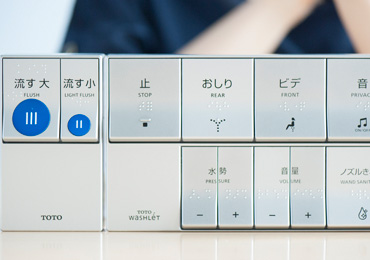We recently introduced an innovative toilet tank for public toilets, along with a Washlet that also has amazing features, particularly its eco-friendly control panel. When the user presses the buttons, they generate the power the panel needs to operate. Thus, neither a power-supply system in the wall nor battery changes are necessary. The new pushbutton keys have an elegant shape and excellent feel. It is extremely difficult to provide both the capability of self-power generation and operability to a device. But this was accomplished by a woman engineer who tirelessly conducted the necessary research and development to complete a commercial product. She pursued not only self-power generation capabilities but universal operability. This Green Story takes you behind the scenes of her efforts to develop the eco-friendly control panel.

Satoko Morioka
Electronic Devices Research and Development Section, Electronic Devices Development
Morioka joined TOTO in 2006 and was engaged in the research and development of restroom products. In 2011, she began to work on wireless power devices. In 2013, she was transferred to the Electronic Engineering Division in Kokura City.

“I came up with the idea of creating an off-grid smart control panel for TOTO’s Washlet that generates power itself when the user presses a button, after I saw a small non-utility switch. I liked it because it does not need a power supply. However, the user needed to press the switch really hard to use it, because the amount of electricity generated by one press was meager. At TOTO, I had been working in the research laboratory, and it was impossible for me to start a development project without the prospect of commercialization.
“By 2011, wireless connections had become much more refined, lowering power consumption by 99%. This led me to the idea of creating a device that actually generates the power for its wireless connection itself. Based on my calculations, the power generation and consumption in the device would break even. So I thought this could be used for a control panel and created a prototype model. In retrospect, I was dreaming of a bright future at the beginning of the process. (Laughs.) I never expected that I would have to struggle so hard for more than three years to complete the device.
“First, I visited every business division in the company to show the prototype I had just made. Everyone said, “The idea is nice,” but they never adopted it for their business. The model was, after all, just an idea just cast into a shape. It was bulky and the button was not easy to press. Whenever they had it in their hands, they would say, “It’s too heavy.”
“Operability was the biggest problem. This is no wonder, since the button for TOTO’s conventional control panels was only 1mm and could be operated with very little pressure. The tiny metal dome of the “tact switch” yields under your finger and never fails to give you the feel of a click. I was impressed by its high quality. (Laughs.)
“However, I believed that future control panels should be eco-friendly. Actually, eco-friendliness was the key to improving our products for public toilets. Ideally, for the convenience of the user, a public toilet should have a control panel for the flush and Washlet system installed on the wall that are easy to find and use. However, it’s really a bother to change the battery or install the power supply system in the wall, and that is why many public toilets have given up on installing a control panel on the wall.
“Now, a non-utility wireless control panel would solve the problem. I made up my mind to continue my research to develop one. I conducted electromagnetic analyses and experiments every day, over and over again. But the hardest part was yet to come.

A test mockup developed from the prototype. The user needed to press the switch really hard to use it.

Morioka selected this small generator to generate the control panel’s power.
↑ page top


She created a variety of models to test the feel of pressing the
button.
“Usually, the job of a lab researcher is to make a prototype model, and that is all. After that, R&D staff will complete the job. However, I was determined to do anything to commercialize this product. So, with a prototype featuring improved power generation efficiency, I moved from the lab in Chigasaki City, Kanagawa Prefecture to the R&D Department in Kokura City, Fukuoka Prefecture.
“In fact, I had never commercialized a product from the results of my own research. The first challenge was to achieve a thin control panel, less than 25mm thick. At that time, no matter how much tried, I could not get it less than 35mm. In addition, although the number of the buttons for the device had originally been four, it increased to nine in the final plan! Nine buttons that should be powered by one generator?! No such non-utility switch existed in the whole world! (Laughs.)
“A bulky control panel for public toilets would not be allowed on the market, because some users might put their hand on it and shift their weight onto it. It might also look unsophisticated on the wall. I realized how difficult it would be to create a commercial product. After having made a number of samples to thoroughly examine the design of the mechanism, I finally made it thin enough.

Eventually, she selected this refined light-touch switch.
“In addition, public toilets are used by a variety of people, including some who are suffering from an illness and don’t have enough strength in their hands. For a residential product, a family can choose what kind of toilet and control panel they want, but public toilets have to be universal. So, I measured every switch I found with a push-pull gauge, a measuring instrument to test tension and compression, and a ruler. (Laughs.) Buttons of elevators, interphones, gas stoves in the kitchen — everything in our daily lives. I just wanted to know what the market demanded as the limit of operability.
From my analysis of the results, I found that if a button has a certain stroke, it is easier for us to press even if it requires a bit more strength.
“Non-utility switches for lights in the home were the ideal model for me. It is easy to press them because they have a longer stroke, and a longer stroke generates more energy. So, although 4mm is enough to generate sufficient energy, I made my stroke 7mm to generate more power by using the principle of leverage. Through a lot of trial and error I found the right shape. The comments from the monitors involved in our surveys were most useful. Although we did not tell them that the control panel is non-utility, in a survey conducted during the last phase of development, most monitors gave positive comments, saying that our model was easy to press and understand. Some monitors were blind, some were senior, and others had less strength in their hands. So, when everyone said they were satisfied with our product's quality, I was very happy.
↑ page top

“The new eco-friendly control panel has many features other than its power-generating capability. One feature that is I am sure will be welcome is the button to clean the Washlet’s nozzle. With the press of this button, antibacterial water cleans the nozzle before you use it, so some users who felt uncomfortable using the Washlet in a public toilet can feel safe about using it now.
“In fact, conventional Washlet models already have this self-cleaning function, but many women, especially, did not feel safe without doing it themselves. They are very nervous about hygiene, and that’s why they wipe the toilet seats with sanitizing clothes or use seat covers when they sit. I hope they will use the self-cleaning button instead. I know this may sound awkward, since I wanted to reduce the number of buttons. (Laughs.)
“For the pushbuttons, I was obsessed about details such as the smoothness of the surface, the beauty of the curved ends and the quality of the material. So I hope many people will notice the excellent feel of pressing the buttons. And I hope this control panel will contribute to energy savings. I want to make these buttons a TOTO standard in the future. This is my dream now, so I really think my three-year struggle was a very good experience for me.

The elegant contour of the buttons is visible in profile.

To achieve universal operability, Morioka worked tirelessly to identify the best shape and arrangement of the buttons.
↑ page top











